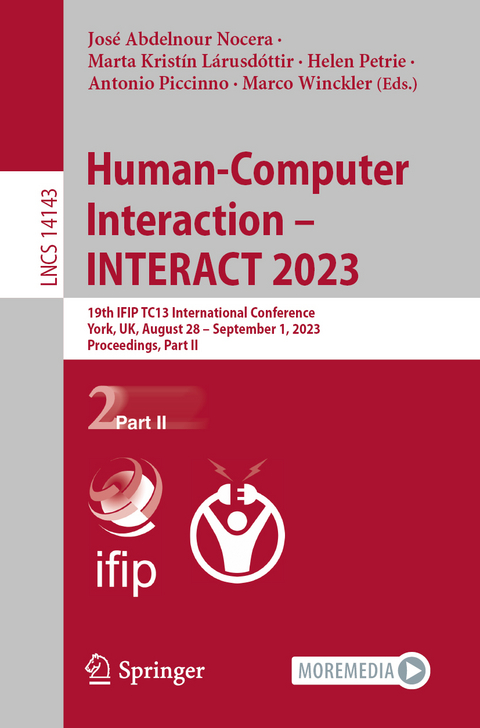
Human-Computer Interaction – INTERACT 2023
Springer International Publishing (Verlag)
978-3-031-42282-9 (ISBN)
The 71 full papers and 58 short papers included in this book were carefully reviewed and selected from 406 submissions. They were organized in topical sections as follows: 3D Interaction; Accessibility; Accessibility and Aging; Accessibility for Auditory/Hearing Disabilities; Co-Design; Cybersecurity and Trust; Data Physicalisation and Cross-device; Eye-Free, Gesture Interaction and Sign Language; Haptic interaction and Healthcare applications; Self-Monitoring; Human-Robot Interaction; Information Visualization; Information Visualization and 3D Interaction; Interacting with Children; Interaction with Conversational Agents; Methodologies for HCI; Model-Based UI Design and Testing; Montion Sickness, Stress and Risk perception in 3D Environments and Multisensory interaction; VR experiences; Natural Language Processing and AI Explainability; Online Collaboration and Cooperative work; Recommendation Systems and AI Explainability; Social AI; Social and Ubiquitous Computing; Social Media and Digital Learning; Understanding Users and Privacy Issues; User movement and 3D Environments; User Self-Report; User Studies; User Studies, Eye-Tracking, and Physiological Data; Virtual Reality; Virtual Reality and Training; Courses; Industrial Experiences; Interactive Demonstrations; Keynotes; Panels; Posters; and Workshops.
Human-Robot Interaction.- Pedestrian Interaction with a Snow Clearing Robot.- Robot Collaboration and Model Reliance Based on its Trust in Human-Robot Interaction.- User Experience in Large-Scale Robot Development: A Case Study of Mechanical and Software Teams.- Information Visualization.- BiVis: Interactive and Progressive Visualization of Billions (and Counting) Items.- Modeling and Assessing User Interaction in Big Data Visualization Systems.- The Effect of Teleporting versus Room-scale Walking for Interacting with Immersive Visualizations.- Information Visualization and 3D Interaction.- Playing with Data: An Augmented Reality Approach to Interact with Visualizations of Industrial Process Tomography.- Supporting Construction and Architectural Visualization through BIM and AR/VR: A Systematic Literature Review.- Through Space and Time: Spatio-Temporal Visualization of MOBA Matches.- Interacting with Children.- Awayvirus: A Playful and Tangible Approach to Improve Children's Hygiene Habits in Family Education.- Money from the Queen": Exploring Children's Ideas for Monetization in Free-to-Play Mobile Games.- Motivating Children's Engagement with Sleep Diaries through Storytelling.- The Peer Data Labelling System (PDLS). A Participatory Approach to Classifying Engagement in the Classroom.- WashWall: an Interactive Smart Mirror for Motivating Handwashing Among Primary School Children.- Interaction with Conversational Agents I.- Beyond Browser Online Shopping: Experience Attitude Towards Online 3D Shopping with Conversational Agents.- Effects of Prior Experience, Gender, and Age on Trust in a Banking Chatbot with(out) Breakdown and Repair.- EaseOut: A Cross-Cultural Study of the Impact of a Conversation Agent on Leaving Video Meetings Early.- Interaction with Conversational Agents II.- An AI chat-based solution aimed to screen Postpartum Depression.- The Impact of Gender and Personality in Human-AI Teaming: the Case of Collaborative Question Answering.- Empirical Grounding for the Interpretations of Natural User Interface: A Case Study on Smartpen.- Methods for Evaluating Conversational Agents' Communicability, Acceptability and Accessibility Degree.- Methodologies for HCI.- A Review on Mood Assessment using Smartphones.- A close look at Citizen Science through the HCI lens: a systematic literature review.- The Gap Between UX Literacy and UX Practices in agile-UX Settings: A Case Study.- Model-Based UI Design and Testing.- AdaptReview: Towards Effective Video Review using Text Summaries and Concept Maps.- I perform my work with my body too: integrating body representations in and with task models.- Prototyping with the IVY workbench: Bridging Formal Methods and User-Centred Design.- Towards automated load testing through the userinterface.- Montion Sickness, Stress and Risk perception in 3D Environments.- "Do I Run Away?": Proximity, Stress and Discomfort in Human-Drone Interaction in Real and Virtual Environments.- Sick in the Car, Sick in VR? Understanding how Real-World Susceptibility to Dizziness, Nausea, and Eye Strain Influences VR Motion Sickness.- Spatial Augmented Reality in the Factory: Can In-Situ Projections Be Used to Communicate Dangers and Health Risks?.- Multisensory interaction and VR experiences.- Augmenting Indigenous Sámi Exhibition - Interactive Digital Heritage in Museum Context.- Design Paradigms of 3D User Interfaces for VR Exhibitions.- Multisensory Diorama: Enhancing Accessibility and Engagement in Museums.- Museum Visitor Experiences based on Hyperspectral Image Data.
| Erscheinungsdatum | 26.08.2023 |
|---|---|
| Reihe/Serie | Lecture Notes in Computer Science |
| Zusatzinfo | XXX, 651 p. 175 illus., 143 illus. in color. |
| Verlagsort | Cham |
| Sprache | englisch |
| Maße | 155 x 235 mm |
| Gewicht | 1021 g |
| Themenwelt | Mathematik / Informatik ► Informatik ► Betriebssysteme / Server |
| Informatik ► Software Entwicklung ► User Interfaces (HCI) | |
| Schlagworte | Artificial Intelligence • Communication Systems • Computer Hardware • Computer Networks • Human-Computer Interaction (HCI) |
| ISBN-10 | 3-031-42282-1 / 3031422821 |
| ISBN-13 | 978-3-031-42282-9 / 9783031422829 |
| Zustand | Neuware |
| Haben Sie eine Frage zum Produkt? |
aus dem Bereich


